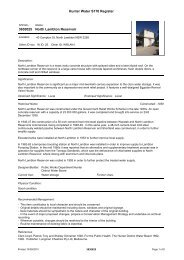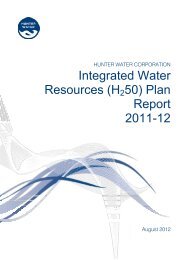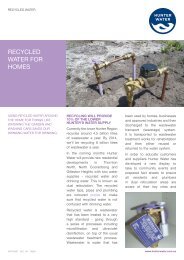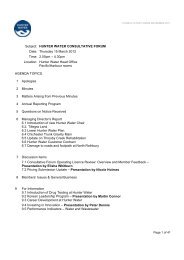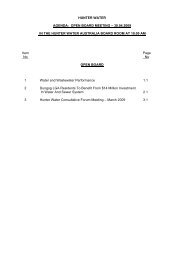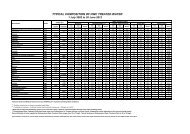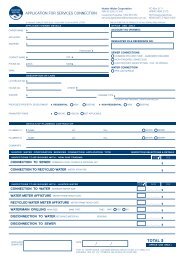Water Kit - Hunter Water
Water Kit - Hunter Water
Water Kit - Hunter Water
Create successful ePaper yourself
Turn your PDF publications into a flip-book with our unique Google optimized e-Paper software.
2.5 water conservation initiatives<br />
When introducing new ideas it is<br />
important to test the idea first to<br />
see if it is worthwhile. <strong>Hunter</strong> <strong>Water</strong><br />
often works in partnership with other<br />
organisations to investigate water<br />
saving ideas and how well they may<br />
work when applied to the broader<br />
Lower <strong>Hunter</strong> community.<br />
eco-friendly home<br />
An eco-friendly home at Tighes<br />
Hill showcases best practice for<br />
sustainable living. This includes 40,000<br />
litre rainwater storage tanks to supply<br />
all water needed by the family.<br />
The house has water-free composting<br />
toilets. Grey water from washing<br />
machines and showers are used to water<br />
garden areas. Efficient shower roses and<br />
a front loading washing machine have<br />
been installed. Native grasses and trees<br />
have been planted and these have an<br />
advantage of being drought resistant.<br />
The home will save on water and energy<br />
costs and also showcase a sustainable<br />
alternative for Lower <strong>Hunter</strong> residents.<br />
This eco-friendly home is setting a new<br />
benchmark in terms of environmentally<br />
friendly living in the Lower <strong>Hunter</strong>.<br />
Berni Hockings at his energy and water efficient<br />
home in Tighes Hill<br />
Kotara Roof to Creek Project<br />
Developed by <strong>Hunter</strong> <strong>Water</strong>, Newcastle<br />
City Council and The University of<br />
Newcastle, this community project has<br />
involved the installation of rainwater tanks<br />
on individual properties, and changes to<br />
landscaping in public areas of Kotara.<br />
The project aims to conserve mains<br />
water use and to reduce the quantity<br />
and velocity of stormwater runoff leaving<br />
the catchment. The project monitors<br />
mains and rainwater use, and rainfall and<br />
runoff from the catchment. The project<br />
also looks at community attitudes and<br />
behaviour, motivations for installing<br />
<strong>Water</strong> kit . ssS . 001 . april 2010<br />
rainwater tanks and the most effective<br />
and affordable ways of retrofitting<br />
rainwater tanks.<br />
Rainwater tanks replace drinking water<br />
for watering gardens<br />
The ‘Roof to Creek’ project has installed<br />
16 rainwater tanks in Kotara households.<br />
The project involved house-to-house<br />
briefings to advise residents of the<br />
project’s benefits and the involvement<br />
required. Each resident’s yard was<br />
assessed to determine the suitability,<br />
size and location of their respective<br />
rainwater tank.<br />
The project tested the value of rainwater<br />
tanks in addressing a stormwater problem<br />
in the catchment. It is also providing<br />
a testing and verification ground for<br />
research undertaken by the University<br />
into modelling of water flows and rainfall.<br />
The three-year project has also involved<br />
retofitting water efficient devices.<br />
Monitoring, evaluation and education has<br />
taken place throughout the entire project.<br />
family installs rainwater tank<br />
A local engineer has installed a rainwater<br />
tank at his home to supply about 70% of<br />
his family’s water when there is sufficient<br />
rain. In dry times, most of the water comes<br />
from the mains supply. The 4,500 litre<br />
tank supplies water to the toilet, washing<br />
machine and outdoor tap.<br />
The family estimates that an average of<br />
40% of their household water will come<br />
from the tank throughout the year; this<br />
equates to around 80 kL per year. Even in<br />
dry years, the tank will supply a lot<br />
of water.<br />
In order to achieve these levels of mains<br />
water reduction, the rainwater tank had to<br />
be connected to appliances that are used<br />
throughout the year, such as toilets and<br />
washing machines. Less than half of this<br />
amount of this water would be saved if the<br />
tank were only connected for garden use.<br />
If the rainwater tank runs low it can be<br />
‘topped up’ with water from the mains<br />
water supply. This ensures the tank<br />
never runs out of water and the supply of<br />
water to appliances is never disrupted.<br />
The top up is only activated when tank<br />
levels drop significantly. It does not refill<br />
the tank. Instead it ensures the water in<br />
the tank does not drop below a specified<br />
level. Without rain, the tank lasts about<br />
two weeks before the mains top up is<br />
activated.<br />
It takes at least 600 millimetres of rain<br />
per year to generate streamflow into our<br />
Lower <strong>Hunter</strong> reservoirs. Using rainwater<br />
tanks, however, a large proportion of any<br />
amount of rain can be collected via house<br />
roofs. The result is that rainwater tanks<br />
can achieve reduced demand on <strong>Hunter</strong><br />
<strong>Water</strong> reservoirs and other infrastructure<br />
(ie pipes, pumping stations) even in times<br />
of drought.<br />
To monitor how much water could be<br />
supplied from the family’s tank, <strong>Hunter</strong><br />
<strong>Water</strong> installed two water meters at<br />
the home. The university is using the<br />
rainwater tank as part of research into<br />
tank dynamics and their associated health<br />
implications.<br />
The Berghout’s rainwater tank saves 40%<br />
of potable water usage.<br />
Did you know?<br />
• Rainwater tanks come in all shapes<br />
and sizes, from small 600L slimline<br />
tanks to very large 45,000L tanks<br />
for rural use - the typical tank for<br />
residential purposes is 5,000L.<br />
Every 1mm of rain on 1m2 of roof<br />
amounts to 1L of water.<br />
• The size of tank that will suit your<br />
circumstances depends upon the<br />
footprint space available for the<br />
tank, the roof catchment area that<br />
feeds into the tank, rainfall patterns<br />
in your area, and your use of the<br />
collected water.<br />
• Rainwater can be used on the<br />
garden and for water supply to<br />
toilets and cold water taps in the<br />
laundry - this accounts for 60% of<br />
average household water use.<br />
11




